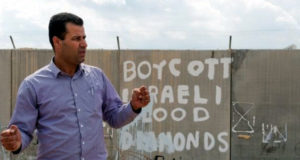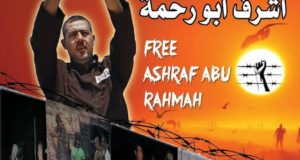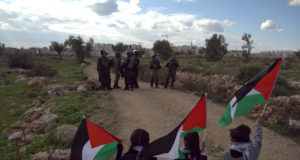by Abdullah Abu Rahme,
Bil’in is a small, peaceful village surrounded by hills and valleys, lying halfway between Yaffa and Jerusalem and is among the villages that fall under the governorate of Ramallah, 16km west of Bil’in. It has a population of 1800 in an area approximately 4000 dunums in size. Its people are known for their simplicity, hospitality and for being good neighbors to each other. They love peace and freedom, and reject injustice and oppression.
The territory which makes up Bil’in has stood up to confiscation time after time, exploited for the purpose of illegal settlement. At the beginning of the 1980s, the Matityahu settlement was built on a portion of Bil’in land and, at the beginning of the 1990s, another portion of land was confiscated on which the Kiryat Sefer settlement was built. And at the start of the millennium in 2002, yet another new settlement (this one named Matityahu East) was built on Bil’in’s land.
In April 2004, Bil’in’s Village Council relayed the Israeli government’s intention to build a “separation wall” on the village lands. The Council delivered this message to the citizens of the village, who in turn compelled them to form a committee to resist this wall and additional resulting settlements. The committee’s aim was to represent the largest section of the village’s residents, to prepare daily and weekly actions, maintain close relations with international and Israeli solidarity activists, keep track of the legal suit filed on behalf of the citizens, and keep in contact with the lawyers and legal advisers in relation to this.
The Israeli army bulldozers began work in Bil’in on February 20, 2005. The wall now traverses the village at a length of 2 kilometres, a breadth of 30 metres, and is 5 kilometres inside the “green line”, the supposedly legal border separating the West Bank and the lands occupied by Israel in 1948. The wall is being built under the pretence of protecting Israel, but as the citizens of Bil’in have made no threat to the lives of the settlers, the goal is not truly security (as claimed) but rather theft of land and settlement construction on that land once stolen. Approximately 1000 olive trees, the life-blood of the community, have been uprooted and destroyed to make way for this wall, which separates the citizens from their own land and orchards. Most of the village’s land (2300 dunums) lies west of (i.e., inside of) the wall, and is planted with olive trees, which is considered the primary source of livelihood. The actual number of olive trees falls somewhere between 100,000-150,000. The rest of the land is used for sowing seeds/grains, planting vegetables, and sometimes as grazing land for livestock.
Throughout this land confiscation we have noted that the wall has considerably affected the village’s economic resources. The land that has remained on the eastern side of the wall is limited (1700 dunums) and is the space on which the houses of the village are built. The section of land nearest the wall is barren, as use for residential purposes is forbidden, and thus has pushed many village residents to buy land from neighbouring villages or emigrate to the city or to Western or foreign countries. All of the aforementioned choices require large financial sums, and by virtue of the destruction of economic resources, fulfilling them is often impossible.
Bil’in’s citizens face two choices – either living in disgraceful circumstances that force them and their grandchildren to live at the lowest level of poverty, or even worse, voluntary migration. Since most have refused both these options, the only remaining choice for them is the popular resistance, expressing their rejection of Israel’s planned encroachment. With this non-violent resistance, they express their attachment and devotion to their land. And they will strive to come onto this land, whatever the cost they may pay, and work to destroy, pull down and remove this wall from their homeland.
The Preparatory Stage
This phase began with the formation of the Popular Committee, in which the National Committee to Resist the Wall played an effective role. The coordination and meeting with international solidarity activists began, especially the International Solidarity Movement (ISM).
With Israeli solidarity activists, we studied the area and the possibilities available to us for continuing action, in addition to meeting with lawyers and familiarizing ourselves with the legal situation Bil’in faced. This was combined with visits to officials in the Palestinian Authority, explaining to them the dangers of this wall to the village. We called for quick political mobilization by them, hoping to head off things before the actual work on the wall, and destruction of our land, began.
At the outset
There was some initial work begun by the bulldozers before we had organized actions that expressed our unequivocal refusal and insistence on remaining and working on our land, but as noted earlier, the real start was the first day of the bulldozers’ work on February 20th, 2005.
Popular demonstrations were our prevailing actions, in which children, youth, elders and women participated and which initially occurred on a daily basis. We then became more organized and focussed, turning quantity into quality, so that two demonstrations were carried out weekly, one of which was agreed to be on Fridays, and the other on another day, most often a Sunday. They took on an organized structure that relied on the participants. Special occasions, national and social holidays were often used, so there was a march of women on Women’s Day, a march of children on Children’s Day, a parade of the handicapped on the Day of the Handicapped and yet another march of the workers on May Day, and so on.
Creativity
The action of chaining ourselves to the olive trees was the epitome of creativity, where the spirit of nonviolent resistance was made evident, and which exemplified the attachment of the Palestinian people to the roots of these sacred trees. This action opened the way for a number of other actions of its kind, making use of barrels, boxes/crates, a makeshift metal cage and gallows, coffins and gravestones, adhesive tape, mirrors, cardboard snakes, a solid iron bridge, columns, a mass grave, a huge Palestinian flag, lots of small flags, the scales of justice, black flags and so on.
Most of the aforementioned props were used in actions that expressed the persistence of the Palestinian family in holding on to their land, and the damage that the wall causes to the citizens of Bil’in, transforming their lives into a living hell. All of the actions made clear the position of the human being who possesses nothing but his/her will in standing in front of the bulldozers, courageous in comparison to the Israeli military’s reliance on an arsenal of weapons and soldiers armed to the teeth with semi-automatic rifles, sound bombs, tear gas, rubber bullets, and live ammunition. The distinction is stark here as they use the ugliest and most violent means of suppressing simple peasants who would, in one instance, chain themselves to an olive tree or, in another, to the corners of the wall, or in another instance lock themselves to barrels in front of the bulldozers. The overwhelming attempts by the Israeli military to suppress these actions paradoxically played a significant role in attracting both Israeli and international solidarity activists, encouraging them to stand with us and next to us, and play a larger role in participating in this variety of actions with us. Additionally, the creativity of these events contributed to attracting media coverage, spreading our message both faster and on a larger level.
Moving the Battle behind the Wall
A group of profiteers, embodied in the president of the Mod’in Illit municipal council, the Green Park, “Haftseeba” building companies, and some functionaries in the town administration, built the Matityahu East Settlement without obtaining authorization from the Israeli government. Israeli solidarity activists helped in exposing the paperwork as forgeries. These profiteers took advantage of the destructive military operations occurring in the West Bank between 2002-03, and the fact that the Palestinian people were not only preoccupied but scared of coming near these encroachments, where contracted security companies would open fire at anyone who tried to approach.
The response from the Popular Committee was to place a mobile home on the land, thus annexing it to the illegal Israeli structures, with the distinction that we own the land on which we placed our home and they donn’t. They demolished the first mobile home, and promptly seized the second one. We had no choice then but to erect a small but permanent structure…a home made up of one room. This was tantamount to a transformation in our struggle, and on December 25, 2005, the house was declared to be the Center for Joint Palestinian-Israeli-International struggle. After that, our lawyer succeeded in obtaining a Stop Work Order(i.e., a reprieve) on the work and expansion of that settlement.
Our new Center has been used for meetings and talks to explain the wall and the demonstrations, in addition to other community activities such as the showing of World Cup matches. The Center itself gave birth to yet another nonviolent action, where some of the families from the village came to live in one of the settlement’s unoccupied houses, to which they took the basic necessities they needed to stay, in addition to papers certifying ownership of the land. They proudly raised the Palestinian flag above the house in that settlement. Not surprisingly, after five hours they were forced to evacuate the house. Our lawyers succeeded in obtaining an order to destroy the illegal structure, along with four other illegally-built units, and to return the soil back to its original state, which was its use for agricultural purposes. This is what the Popular Committee strives for – to spur the people to come on to their land and work it. And indeed the tilling and plowing period has been full of activities linked to this.
On the down side, it must be pointed out that the wall was completed in April 2006, and the Israeli army locks the gate that connects the citizens to their land, but the army is also obligated to remain there around the clock, and is supposed to permit the citizens to cross whenever they want, day or night.
The Response of the Army
From the first moments of the start of this battle to build the wall, the army posted guards with the bulldozers that were working on it; guards whose aim it was to try and suppress the protest actions and prevent demonstrators from approaching the wall. The military employed a number of means to dissuade the demonstrators from continuing their struggle. They began by using batons to beat the demonstrators in a violent and painful way. This gradually developed into the use of gas of various kinds, sound bombs, metal bullets coated with different kinds of rubber, and the use of new weapons such as salt pellets (which literally force salt into the wounds they create), electrical weapons (such as tasers), high-velocity bean bags shot from a gun, and blasting people with high-pressure water hoses. The army’s use of these weapons resulted in injuries to at least 600 people, with some individuals incurring injuries more than ten times during the course of these “battles”.
The army also used collective punishment on the people of Bil’in. It put checkpoints on the roads, which was especially damaging to the workers heading into Israel as it prevented them from getting to their jobs. They forbade citizens from obtaining the permits they needed to cross into Israel. And on top of all this, they besieged the village while preventing international and Israeli solidarity activists from reaching Bil’in, especially on Fridays, when there was always a nonviolent protest against the wall. They imposed curfews on the village and prohibited movement, declaring Bil’in to be a closed military zone, and distributed statements urging residents not to participate in the marches and not to leave their homes at all on Fridays.
Finally, the army used undercover agents known as “musta’ribeen” (agent provocateurs who act, speak and make themselves look like Palestinians) amongst the ranks of the demonstrators to commit violent acts such as throwing stones at the army and so on, thus justifying the army’s use of violence at the demonstrations.
The village was exposed to nightly raids and searches in which the army used the ugliest and most violent measures to spread terror and alarm in the hearts of the citizens, such as throwing sound bombs at them, breaking down their doors and gates in a manner that can only be described as barbaric, and hauling out their children (primarily young men and most especially those who participated in the marches). They would beat and then arrest these youth. These night raids resulted in the arrest of fifty young men, some of whom were sentenced to four months imprisonment and fines ranging from one to two thousand shekels. Some of those village residents that did not possess a Palestinian (PA) identity card were deported to Jordan
In conclusion, what must be emphasized is that all these measures, where certain Israeli military commanders have excelled themselves, have proved fruitless and have not prevented the demonstrators from continuing their struggle. The people of Bil’in and those in solidarity with them have, from the first moment, had their eyes fixed on an objective that is still before them. They see nothing but it. And that objective is to destroy this apartheid wall and its settlements, regain the freedom to cultivate their land, and to work and move about their land in freedom, in safety, and in peace.
translated by Sunbula
 International Solidarity Movement Nonviolence. Justice. Freedom.
International Solidarity Movement Nonviolence. Justice. Freedom.


